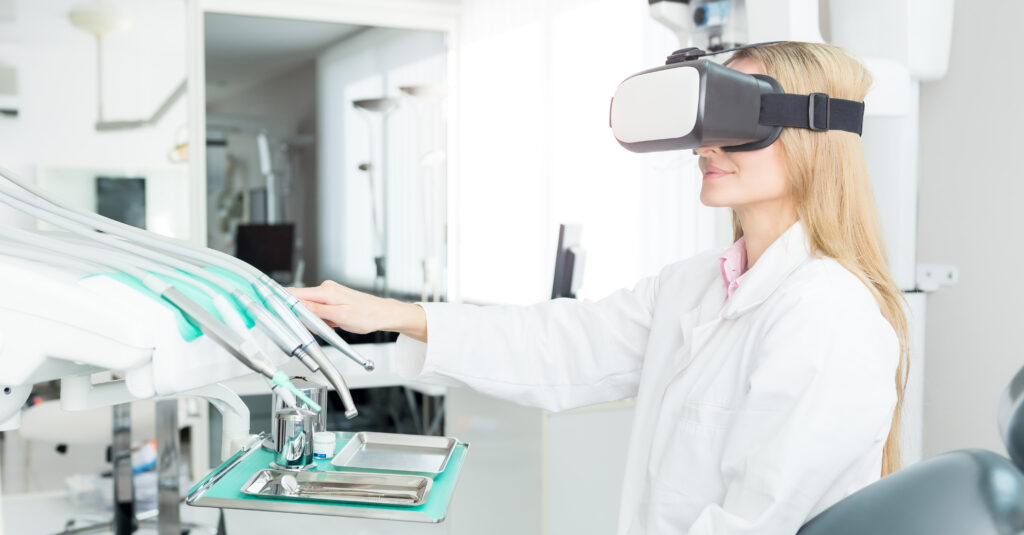What’s ahead for dentistry in 2022 and beyond?

The arrival of COVID-19 followed by the rapid development of vaccines created a bumpy, unpredictable couple of years for the field of dentistry. That turbulence has left everyone in the industry wondering and worried about what’s ahead in 2022. Here are our thoughts about what lies ahead for the field of dentistry next year and beyond.
1. Staffing will remain a major issue in the wake of the pandemic
The arrival of COVID-19 brought huge changes to nearly every aspect of American life, and dentistry was no exception. From the total suspension of non-emergency dental care at the peak of the outbreak to the adoption of updated infection control practices, the pandemic has had a major impact on the dental profession. It’s safe to say we’ll continue to see and feel the reverberations throughout 2022.
While more and more patients are returning to the dentist for routine care and other procedures, almost half of dentists report that hiring new staff post-outbreak is the No. 1 factor limiting volume. A poll from the American Dental Association found that 35.8% of owner dentists are currently recruiting dental assistants, 28.8% are seeking dental hygienists, 26.5% are looking to hire administrative staff and 13.1% are in search of associate dentists. More than 85% of these dentists said that hiring for a position like dental hygienist was much more challenging than before the pandemic.
This disparity between staffing and volume won’t be soon or easily resolved, and we predict it will be one of the major issues for dentistry in 2022.
2. Teledentistry will continue to grow
Teledentistry understandably picked up steam during the pandemic. Services like Delta Dental’s Virtual Consult provide easy and safe access to dental care.
An analysis of Google trends published by the Journal of Clinical Medicine found a five-time increase in query rates for “teledentistry” during the COVID-19 pandemic. Any new growth is somewhat restricted by teledentistry’s limitation to triage and advice. Nonetheless, according to DocASAP’s annual State of Patient Access and Engagement survey, 40% of people would switch health care providers based on availability for both telehealth and in-person visits. Teledentistry is having a moment, and it’s likely to last into 2022 and beyond.
3. New tech will continue to reshape the industry
Dentistry is a field that’s defined by innovation. Some of the technologies we’ll have our eyes on for growth in 2022 and beyond include:
- Augmented reality. AR has found a home in dentistry for both educational and clinical purposes. But look for it to become more and more prevalent in reconstructive and aesthetic procedures in the near future. AR apps use a digital camera to overlay virtual depictions of an improved set of teeth prior to a procedure. This allows patients and dentists to configure features such as height and spacing to their liking before they even enter the surgery room.
- Virtual reality. VR completely closes off the outside world with a dedicated headset and immerses the user in a virtual environment. By slipping such a headset on their head, students and aspiring dental surgeons can be transported to the operating room, or patients can visualize a calming landscape while seated in the dentist’s chair to improve their experience.
- 3D printing. As this technology is set to become an integral part of many healthcare practices, it’s also becoming more and more incorporated into dental labs. With a 3D printer doing the hard work, dental labs can eliminate the bottleneck of manual modelling and quicker creation of crowns and bridges.
- Chatbots. Up to 80% of customers’ frequently asked questions could be answered by a chatbot, according to estimates by IBM. It’s no wonder that the healthcare chatbot market is expected to reach $967.7 million by 2027. Chatbots can streamline inquiries and save office staff time by answering routine questions and even scheduling appointments. The technology has the potential to save businesses up to $8 billion in 2022, according to IBM.
- Appointment confirmation software. Like chatbots, appointment confirmation software automates a previously time-intensive process prone to error and neglect. Many appointment confirmation software systems even offer patients the option to make their own appointments. In 2022, look for confirmation software to continue to integrate with online payment, virtual dentistry and other office and data collection software.
4. Dentistry will get greener
Dentistry is an energy- and resource-intensive field with a significant environmental impact. Dental practices discard approximately 680 million chair barriers, light handle covers and patient bibs, as well as 1.7 million sterilization pouches each year, according to the Eco-Dentistry Association. Many dentists are responding to concerns over the practice’s carbon footprint, and patients are becoming more likely to choose environmentally conscious practices. The industry continues to respond to providers’ and patients’ concerns about the environment, with new high-tech innovations often allowing for waste reduction. In 2022 and beyond, we predict that more dental practices will seek ways to reduce pollution and to serve the wellness lifestyle that more patients are choosing.
Recent posts
- Delta Dental is partnering with dental schools to offer exclusive CE courses
- Drive better patient experiences with benefit conversations
- Offer care beyond the chair with teledentistry
- Healthy mouths begin with hygienists
- How to educate patients and make them partners in oral health
- Dr. Justin Perdichizzi — serving those who served
- Get your patients to make (and keep) their dental appointments
- One sign-on, many advantages
- Delta Dental hosts in-person Provider Advisory Council in Arizona
- Tooth be told, we love our dentists
